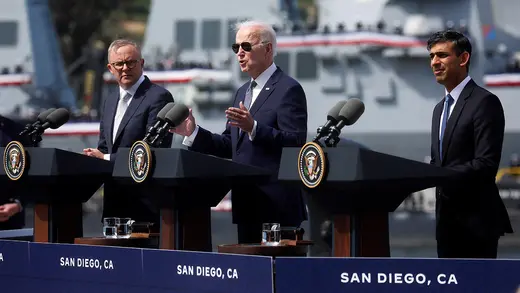In Brief
AUKUS Explained: How Will the Trilateral Pact Shape Indo-Pacific Security?
The fledgling agreement is set to deepen defense cooperation among Australia, the United Kingdom, and the United States, but it could be decades before it delivers on its promise.
What is AUKUS?
Established in 2021, the AUKUS is intended to be a strategic partnership among Australia, the United Kingdom (UK), and the United States to bolster their allied deterrence and defense capabilities in the Indo-Pacific. The trilateral partnership, which builds on their decades-long security cooperation, has two pillars. Pillar I revolves around the acquisition and development of conventionally armed nuclear-powered submarines for the Royal Australian Navy; and Pillar II calls for collaboration on advanced capabilities that will involve technology and information sharing.
What is the submarine component?
Pillar I of AUKUS focuses on Australia's acquisition of conventionally armed nuclear-powered submarines (making it the only country besides the UK with which the United States will share nuclear propulsion technology). This move will significantly enhance Australia’s undersea capabilities, (which mostly operates diesel-electric submarines at present) as nuclear-powered submarines offer many advantages such as extended range, endurance, and stealth—features that have become necessities, given changing geopolitics and shifting defense dynamics in the Indo-Pacific.
More on:
Over the next seven years, Australia will prioritize building up its naval workforce and infrastructure to establish a sovereign nuclear-powered (SSN) capability. SSNs are nuclear-powered but conventionally armed—unlike SSBNs, which carry nuclear warheads. SSN-AUKUS submarines, which will combine British design with American technology, are expected to enter service by the late 2030s and be domestically produced in Australia by the early 2040s. To provide Australia with these capabilities in the meantime, the United States plans to sell 3-5 U.S. Virginia class SSNs to Australia in the early 2030s, and as early as 2027, the United States and the UK will deploy their own nuclear-powered submarines in the region as part of “Submarine Rotational Force-West.”
What is the emerging tech component?
The goal of Pillar II is to collaborate on advanced capabilities that will involve broad technology and information sharing, in order to keep up with increasing geopolitical competition, particularly with the People’s Republic of China. It aims to boost development and interoperability across cutting-edge technologies like robotic and autonomous underwater vehicles, quantum technology, artificial intelligence (AI), advanced cyber capabilities, hypersonics, and electronic warfare. This will span the entire research and development process, from design to deployment.
Despite some regulatory and bureaucratic challenges, Pillar II has already made notable progress. For example, military and civilian personnel from all three countries participated in a trial for aerial and ground vehicles that saw the first interchange of AI models between nations and AI-enabled assets operating in a swarm to detect and track targets. Most recently, the Biden administration announced that it is pursuing interim executive branch actions and proposing legislative changes to facilitate defense trade between the AUKUS partner nations in order to accelerate progress.
How are other states responding to AUKUS?
AUKUS is another prime example of the United States and its allies bolstering security cooperation in the Indo-Pacific to counterbalance China's growing power and influence in the region. It follows other significant efforts, such as ASEAN and the Quad establishing a foundation for achieving “integrated deterrence.”
Responses from other Western partner states in the Indo-Pacific and beyond have been varied but generally positive, welcoming the alliance as a step toward safeguarding regional stability. Lawmakers in New Zealand and Canada have even gone so far as to indicate interest in joining or creating similar, parallel agreements along the lines of Pillar II. However, other states have expressed concerns regarding the potential for an arms race or a destabilizing effect on regional dynamics. China has been a vocal objector, likening AUKUS to an “Asia-Pacific NATO replica” that threatens its regional influence.
More on:
What challenges lie ahead for AUKUS?
Lasting success for AUKUS in deterring regional threats and reinforcing regional stability hinges on participating states overcoming barriers to progress in technology and information sharing, and meeting benchmarks for both Pillars. Achieving these core objectives will take years, with Pillar I likely requiring decades, even with all states moving forward at full speed.
Regardless, AUKUS still holds immediate promise for participating countries. Critically, it will help catalyze technological innovation and enhance research and development for emerging capabilities necessary to maintain a competitive edge, strengthen defense ties, and deepen the three countries’ presence in the Indo-Pacific.
 Online Store
Online Store
